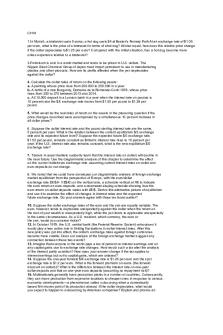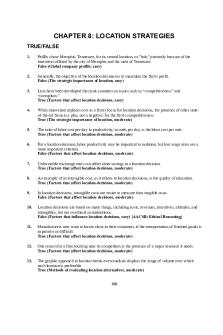MP Ch14 - Summary Principles Of Eco II PDF

| Title | MP Ch14 - Summary Principles Of Eco II |
|---|---|
| Course | Principles Of Eco II |
| Institution | University of Kentucky |
| Pages | 3 |
| File Size | 49.5 KB |
| File Type | |
| Total Downloads | 66 |
| Total Views | 131 |
Summary
Summary by chapter...
Description
Chapter 14 Money, Banks, & the Federal Reserve System Major Points 1. Distinguish between money, income, & wealth. Which one does the central bank control? 2. Distinguish between M1 & M2 measures of the money supply. 3. Bank reserves equal vault cash plus bank deposits with the Federal Reserve. 4. Customer deposits into a bank increase dollar for dollar both bank deposits and bank reserves. 5. Banks create money when making loans from excess reserves. The loans take the form of checking account deposits. 6. A single bank, generally, loans out its excess reserves, while the banking system as a whole, generally, loans out a multiple of its reserves. 7. The multiple by which deposits grow for any given increase in reserves equals, in the simplest case, the simple deposit multiplier, which equals 1/Required Reserve Ratio. 8. The simple deposit multiplier assumes banks hold no excess reserves and the whole amount of every check is deposited in a bank (no one takes any of it out as currency).
9. Real-world Deposit (money) Multiplier < Simple Deposit Multiplier because banks hold some excess reserves, and households and firms keep some currency out of the bank. 10. Our central bank is the Federal Reserve. Be familiar with its three parts: Board of Governors, Federal Reserve District Banks, & the Federal Open Market Committee (FOMC). Who is the Chair? 11. With a fractional reserve banking system and the maturity mismatch between deposits and loans, bank panics cause banks to have severe liquidity problems. 12. The Federal Reserve was established to prevent bank panics by serving as a “lender of last resort.” 13. Fractional reserve banking, the maturity mismatch between deposits and loans, contagion, and asset deflation (know these terms) create in the banking system systemic risk. Hence, the need for a “lender of last resort.” 14. Why does deposit insurance stop bank panics? 15. The “bank panic” during the 2007-2009 financial crisis occurred in the shadow banking system. Why were the firms in the shadow banking system vulnerable to “bank” runs?
16. In what sense was there a run on investment banks? They don’t have deposits. 17. The Federal Reserve has four tools of monetary policy – open market operations, discount policy, reserve requirements, and interest on reserves. 18. Open market purchases of Treasury securities by the Federal Reserve increase bank reserves. Why? Open market sales of Treasury securities by the Federal Reserve decrease bank reserves. Why? 19. Increases in the required reserve ratio decrease the simple deposit multiplier (why?), which decreases the money supply. 20. A decrease in the interest rate the Fed pays on bank reserves increases bank lending and the money supply....
Similar Free PDFs

Principles of marketing CH14
- 52 Pages

Summary Principles of marketing
- 51 Pages

Eco II, Proyecto
- 43 Pages

Math II ECO 2019 - Ejercicios
- 1 Pages

Ch14 - ch14 jjjsjssj
- 4 Pages
Popular Institutions
- Tinajero National High School - Annex
- Politeknik Caltex Riau
- Yokohama City University
- SGT University
- University of Al-Qadisiyah
- Divine Word College of Vigan
- Techniek College Rotterdam
- Universidade de Santiago
- Universiti Teknologi MARA Cawangan Johor Kampus Pasir Gudang
- Poltekkes Kemenkes Yogyakarta
- Baguio City National High School
- Colegio san marcos
- preparatoria uno
- Centro de Bachillerato Tecnológico Industrial y de Servicios No. 107
- Dalian Maritime University
- Quang Trung Secondary School
- Colegio Tecnológico en Informática
- Corporación Regional de Educación Superior
- Grupo CEDVA
- Dar Al Uloom University
- Centro de Estudios Preuniversitarios de la Universidad Nacional de Ingeniería
- 上智大学
- Aakash International School, Nuna Majara
- San Felipe Neri Catholic School
- Kang Chiao International School - New Taipei City
- Misamis Occidental National High School
- Institución Educativa Escuela Normal Juan Ladrilleros
- Kolehiyo ng Pantukan
- Batanes State College
- Instituto Continental
- Sekolah Menengah Kejuruan Kesehatan Kaltara (Tarakan)
- Colegio de La Inmaculada Concepcion - Cebu










